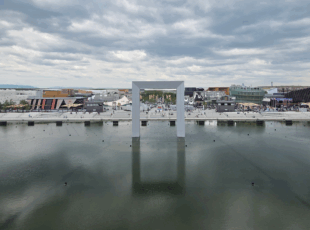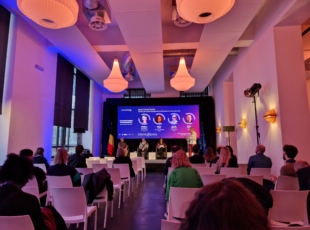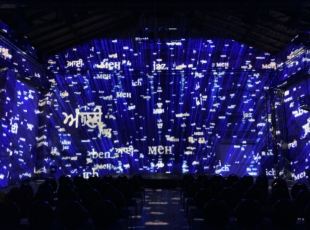When KIKK comes to town

Article author :
Driven by an increasingly powerful desire to open up to the general public, this year the KIKK in Town exhibition took over ten or so interior and exterior venues across the whole of Namur to display some fifty artworks. Consisting of both large showcase sites, interactive installations and performative worlds, kingkong also gave into the temptation of this tantalizing route punctuated with art.
Having totted up the sums, the organisers have laid their cards on the table: the KIKK Festival attracted some 28,000 visitors from Thursday 26th to Sunday 29th, last October. In addition to the over 2,800 sector professionals who turned up to attend the numerous talks, the Namur rendezvous of digital and creative cultures also in particular welcomed 25,000 people to its KIKK in Town exhibition. It’s true that whilst we were there you had to use your elbows at certain key points along the route to glimpse the works and art installations. The interior spaces were sometimes mobbed, with the inclement weather being a factor. But it’s also down to a single and inclusive entrance fee of 5 Euros that the exhibition drew in such crowds. We also came across numerous families on the hunt for tech-artistic surprises. ‘For the under-16s, entrance is even free-of-charge, which makes you want to come along and spend your Saturday afternoon with the kids,’ explains one mother, her left hand on a pushchair, her right one in the hand of her eight-year-old daughter.
Facing the strange ‘bubble machine’, as the little girl enjoys repeating, we also get into the spirit of things and turn the crank handle to create our soap screens. It is in a hall at the Delta that our artistic odyssey begins. And there also that the work ‘Solaris’ and its fluid dynamic hypnotises the toddlers. The reflections of lights and colours, which the artist Nicky Assmann names ‘hypercolours’, are enjoyed up until the soapy threads shatter. On the other side of the wall, our gaze next settles on the ‘Imaginarium of Tears’, the micrographs of tears by the Dutch artist Maurice Mikkers. It remains a complete mystery because we will never know if the owners of these tears shed them during joyful or more painful experiences, but the crystalline patterns they create in the microscope leave us speechless.
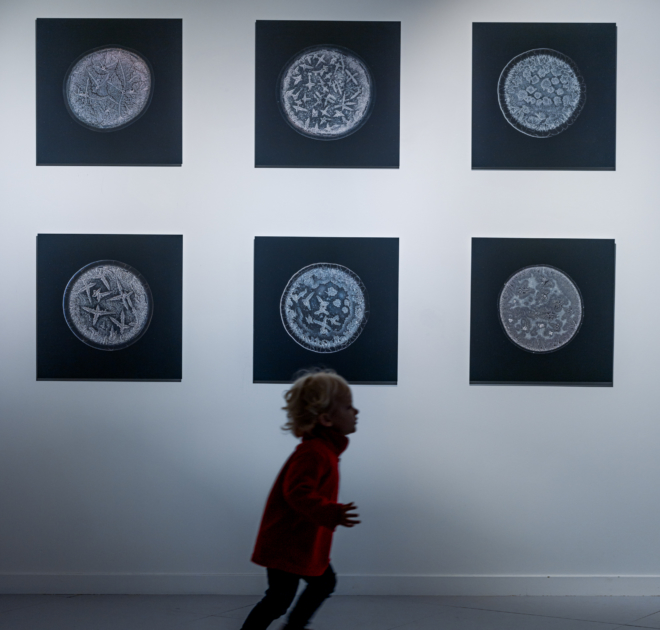
Another installation which messes with our sensitivity to movement: ‘Cycles’, by Martin Messier. Eight wires of light which dance and unfurl before us in cyclical yet equally unpredictable ways. Each viewer is invited to rethink their own relationships with the cycles and restarts which cohabit all around us within nature and our relationships.
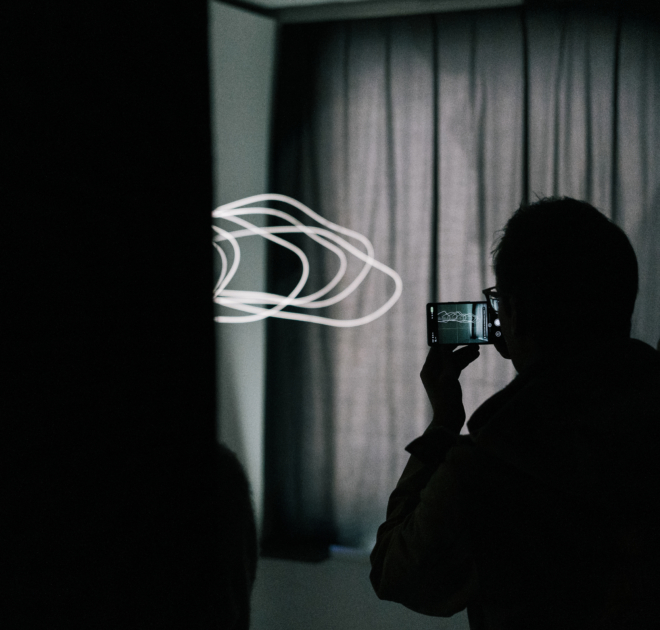

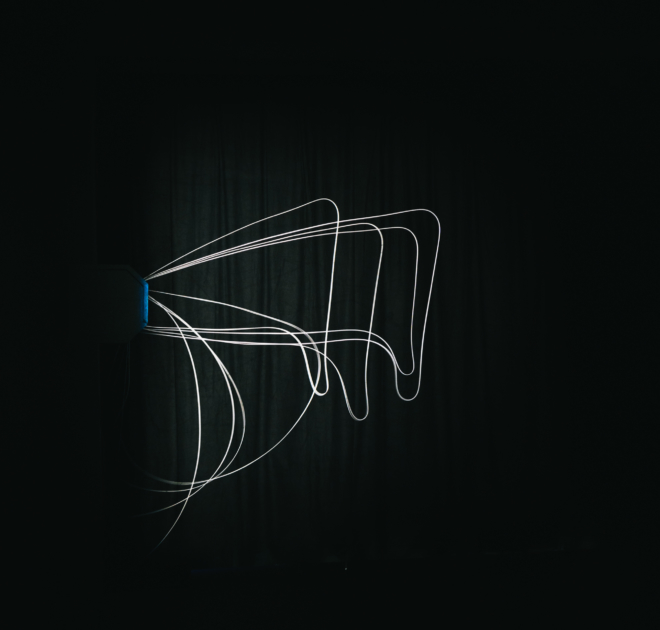
Whilst heading towards the Namur Theatre we naively thought we would clear our mind by attending a performance. Without a sound, we step into the lecture theatre plunged into near silence and slip on a wireless headset. In the spotlights, a young man seems to be in a trance. His lower abdomen is fitted with a strange machine. He allows himself a few sips of a blackish liquid. ‘GUT’, by the Dutch-Iranian director and sociologist Diane Mahín, enables the interior of the human stomach to be heard. In concordance with the amplified sounds in our ears, the performer reacts and thus draws attention to the reasoning between the conscious, instinct and the unconscious. A visceral experience, absurd to some viewers who go back out again with their stomachs quite shaken up. We found it trippy.
To the Pavillon we will go
After this artistic prelude, we make our way to the Pavillon. The Capture #2 exhibition which is being held there until January 15 is also included on the KIKK in Town route. The more athletic go there on foot. A two-kilometre walk for a good hundred metres of elevation gain. A warm-up which others prefer to replace with a trip in a cable car. Even if the queue can be off-putting, it ebbs much quicker since the addition of a few cabins last year. The craftier attendees have got the idea: climb aboard the Namur cable car during the lunch break. The uninterrupted view of the Walloon capital is always worth it. And once on the heights of the Citadel, the digital art centre with the look of a space station is waiting for us.

Capture #2, we have already spoken to you about it in a kingkong article and various portraits of the artists exhibited. The second instalment of a series of exhibitions designed to make visible the digital arts scene on Belgian territory, around 20 multidisciplinary artists based in Wallonia, Flanders and Brussels are presenting their recent works there. Each and every one of them explores technologies to capture and retranscribe the world, in their manner. And the exhibition grabs us as soon as we get through the door. ‘I see a person wearing a hat. I see a group of people leaving the room. I see a person resembling a child running in the room. I see…’ reels off, in English, a speaker connected to a surveillance camera. The ‘Surveillance Speaker’ installation by the artist Dries Deporteer has much to make us smile, so mechanical and rapid is its speech. Some try, in vain, to make it utter swearwords by raising a middle finger in its direction. In its subtext, the work touches on the non-stop developments in respect of surveillance and artificial intelligence (AI).
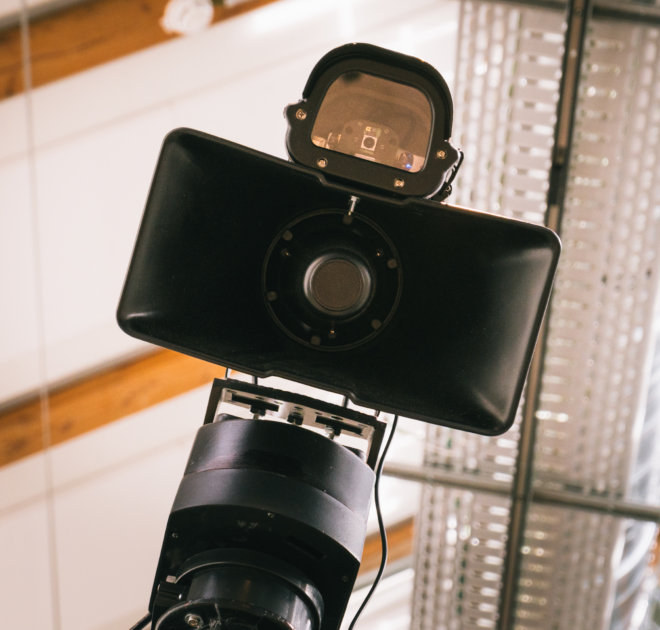
The visual artist and filmmaker Stéphanie Roland, whom we introduced you to in a portrait a few weeks ago, then invites us to enter a camera obscura to give new life to the portraits of people who have been declared missing with ‘Missing people – Inventio fortunate’. Armed with a torch to shine onto acrylic lenses, the visitors make faces appear on the walls. The artist produced these portraits using an AI and wishes to express her indignation at certain dictatorial regimes which, still today, are getting rid of the remains of their opponents, leaving mourning families with an interminable wait.
A lighter mood with ‘Nemo Observatorium’ by Lawrence Malstaf. An authentic meditation machine which fascinates young and old alike, whether you are situated inside or outside this large PVC cylinder. Ventilators project polystyrene particles onto its walls whilst a viewer may sit at its centre. Time seems to expand, then disappear. The same is true when you observe the installations imagined by the assembler artist Vivien Roubaud, ‘Samare stationnaire’ and ‘Salsifis douteux’, which also offer a critique of the extensive control exerted over the living world.
Further on, the transversal theme of the KIKK Festival, ‘Bodies of Water’, resurfaces. In ‘The Mamori Expedition’, Els Viaene replicates the path she took through the Brazilian Amazon forest in 2009. A hydrophone arm plunged into a model of the Amazon river enables you to journey along its meanders of sounds recorded by the artist during her expedition. Or further still, in ‘Nuées’, a single-use installation by Maxime Van Roy in which drops of water wrap themselves up and become their own container, mirrors of a liquid resource which may become increasingly scarce.

Le Grand Manège, the Institut Saint-Louis or the Espace Saintraint… It’s difficult in one day to do the rounds of the ensemble of sites taken over by KIKK in Town. But in going back down to the town centre, we make a last pit stop at the Halle al’Chair, the former Archaeology Museum located in a heritage building constructed in the 16th century. We were by chance passing by on the banks of the Sambre river when we glimpsed through the window strange clams scattered across the floor of the pop-up art gallery.
In this small exhibition space, like a host of other artists who did us the honour of attending the festival with their productions, Marco Barotti welcomes the visitors to a poetic and immersive sonic experience. ‘‘Clams’, a metaphorical reinterpretation of the water quality of the Sambre, takes the form of a collection of fake clams manufactured from recycled waste plastic. Water quality sensors placed in water, several metres from the shellfish, confer on each clam a slight opening and closing movement as well as an understated yet constant sound effect.
On going back to the station, and then on our return train journey, we reflected on all of the artistic sensibilities encountered within a few hours. In the end, KIKK in Town is an enormous orchestra within which each instrument freely expresses itself whilst respecting the others, to enable a polyphony of creativity to emerge. We want more of it, but will have to wait until next year.
A story, projects or an idea to share?
Suggest your content on kingkong.

